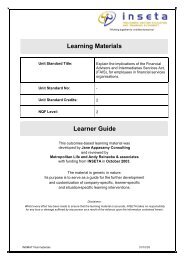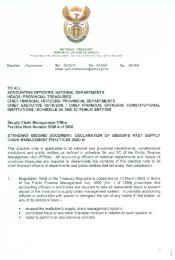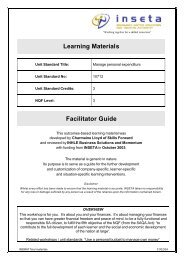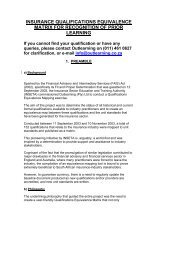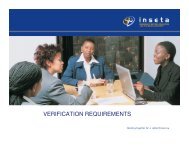SSP Brochure:Layout 1 - INSETA
SSP Brochure:Layout 1 - INSETA
SSP Brochure:Layout 1 - INSETA
You also want an ePaper? Increase the reach of your titles
YUMPU automatically turns print PDFs into web optimized ePapers that Google loves.
Table 3.15 Number of beneficiaries trained on <strong>INSETA</strong> bursary voucher scheme 2006/2007Type of training programmeNumber of learnersSkills Programme (FAIS) 1 201Skills Programme (General) 132SDF Training programme 2ABET 4 Support 546Selling and Marketing Skills 105Legislative Compliance Skills 407Leadership and Management 109Financial Management 4Total 2 506Source: <strong>INSETA</strong> data system3.7 Provision of skills per occupational categoryThe earlier part of this chapter described the provision of skills to the sector in broad terms. However, for the purposes of the <strong>SSP</strong>,mapping of the provision of skills to the specific occupational categories employed in the sector is also necessary.The mapping is done only in terms of the four broad occupational categories that constitute the bulk of employment in the sector. (Table3-15) The analysis of supply in terms of specific occupational categories is also qualitative and tentative for the following two reasons.• There is no specific or unique supply of skills to this particular sector. With the exception of a small number of sector-specific qualifications(most of which have been developed in the last few years), the insurance sector shares in the total supply of financial, administrative andother skills.• Qualifications are seldom narrowly aimed at a particular occupation. Conversely, many positions in this sector could be filled with peoplefrom very different educational backgrounds. Therefore, for most occupations a discrete supply of candidates cannot be quantified. 60Table 3.16 Mapping of the provision of skills to specific occupational categoriesOccupational category Main source of skills Comments on supplySenior Officials and ManagersProfessionalsClerical/AdministrativeWorkersHET/FET trainingIndustry experienceManagement courses (from MBAs to short courses)HET sectorProfessional learnershipsCPE – professional bodies and private providersSchool systemIndustry-specific FET trainingLearnershipsIn-service training by employersFew senior black managers with sufficient industry experienceShortage of skilled black managersHigh turnover among black managersSufficient general output from HET sector, but the sectorcompetes with the rest of the financial services sector and therest of the economyInsufficient industry-qualified professionalsGrowth and transformation in high-level professions is slowLong lead-time before new industry-specific qualifications startto make an impactSufficient numbers of people in the marketLack of numeracy and language skillsService and Sales Workers HET and FET institutions Intermediaries have to comply with FAIS requirementsMany are still struggling with compliance.3.8 ConclusionsMany factors have a positive impact on the supply of skills to the sector:• Various new sector-specific qualifications have been registered, and existing qualifications (such as BCom degrees) now includespecialisations specifically for the insurance industry. The qualifications available to the sector span the whole spectrum from NQF level2 to NQF level 7. Great interest has been shown in the provision of industry-specific qualifications from public and private trainingproviders.• The HET sector output in the field of business, commerce and management sciences has been growing rapidly over the past decade andshould provide the numbers of skilled graduates needed by the sector. However, sector-specific courses are still new and will start tohave an impact only in three to four years’ time.60 The wide range of qualifications that are accepted within the FAIS Fit and Proper regulations testifies to this fact.<strong>INSETA</strong> Sector Skills Plan - page 32






